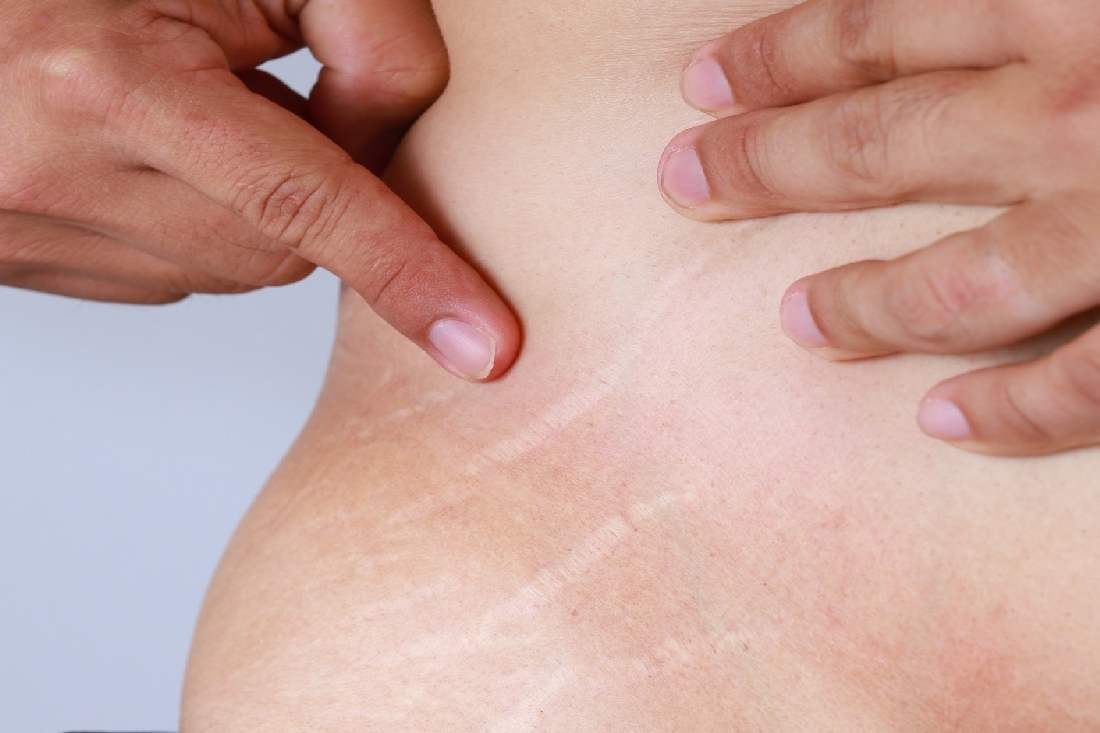Stretch marks, or scar-like lines that appear when the skin stretches and shrinks rapidly, are very common. In fact, data suggests that up to 90 percent of people have stretch marks. Stretch marks, also known as striae, typically appear after pregnancy, puberty, and weight fluctuations. Stretch marks are completely harmless and there is no medical need to treat them. Some people are perfectly comfortable with their stretch marks and choose to embrace them. That’s great! Others may not like their appearance and try very hard to get rid of them. This can make you feel more comfortable with your appearance, which could boost self-esteem.
What Stretch Marks Look Like
Not all stretch marks look the same. They can vary depending on where they appear on your body, how long you’ve had them, and what caused them.
Stretch marks can be pink, red, blue, purple, or dark brown depending on skin colour. They can appear as light streaks or bands on the skin that fade to a lighter colour. Sometimes stretch marks appear to have caved in or sunken in. When they first develop, stretch marks tend to be slightly raised and can be itchy. They can appear on the stomach, breasts, hips, buttocks, or other parts of the body. It is common for stretch marks to fade over time. However, they may never go away entirely.
Signs and Symptoms
Before stretch marks appear, the skin may appear thin and pink. You may also feel irritated or itchy.
Initially, the spots develop as raised, wrinkled streaks that can be red, purple, pink, reddish brown, or dark brown, depending on skin colour. The streaks eventually fade and flatten and tend to change to a silvery colour over time.
Stretch marks can gradually become less noticeable, but this can often take years.
Signs of Stretch Marks
The appearance of your stretch marks can depend on a combination of variables such as E.g.:
- Your natural skin tones
- The health and elasticity of your skin
- The affected body parts
- A different colour and texture than your skin. Its colour can vary from purple to red to light Gray or whitish.
Signs and symptoms of stretch marks include:
- Jagged lines or streaks on the skin that can vary in length and width
- Pink, purple, red, bluish, or dark brown streaks: these coloured markings can vary depending on skin colour your skin
- Fine, shiny lines on the skin that may turn whitish over time
- Itchy, irritated skin before stretch marks appear
Who Gets Stretch Marks?
Stretch marks are a normal part of puberty for most people. Obese people often have stretch marks. Bodybuilders can get stretch marks due to the rapid physique changes that can occur in bodybuilding. People who use skin creams or ointments that contain steroids (such as hydrocortisone) for more than a few weeks can also develop stretch marks. This also applies to people who need to take high doses of oral corticosteroids for months or more.
Risk Factors
Anyone can get stretch marks, but some factors increase your chance of getting them, including:
- Being a woman
- Having a personal or family history of stretch marks
- Being pregnant, especially if you are young
- Rapid growth in the Adolescence
- Rapid Weight Gain or Loss
- Corticosteroid Use
- Breast Augmentation Surgery
- Anabolic Steroid Exercising and Use
- Presence of a Genetic Disorder Such as Cushing’s Syndrome or Marfan Syndrome
How Common Are Stretch Marks?
Stretch Marks Are Common. Between 50% and 90% of All Pregnant Women Develop Stretch Marks.
How Will Stretch Marks Affect My Body?
Stretch marks don’t hurt, but they can affect your mental health. They can make you worry about how others see you. They can also affect the way you think about yourself and your behaviour. They can suffer from stress, anxiety, and depression.
Topical steroids used to treat skin conditions like eczema can also cause stretch marks, especially when applied to areas like the armpit and inner thighs, and groin. Repeated use of steroids can cause thinning of the skin, which can lead to stretch marks.
Certain genetic disorders can also increase the risk of stretch marks. Stretch marks are common in people with Cushing’s syndrome, a condition in which the body produces too much of the stress hormone cortisol. Long-term elevated levels of cortisol can weaken the elastic fibres in the skin, leading to stretch marks.
What Can Remove Stretch Marks?
Like any scar, stretch marks are permanent, but treatment can make them less noticeable. Treatment can also help relieve itching. It’s important to understand that no single treatment works for everyone, and many products don’t seem to work at all. Here’s what researchers have found out about the many treatments for stretch marks.
Creams, Lotions, and Gels for Stretch Marks
Researchers have studied many of the creams, lotions, and gels sold to treat stretch marks. While no product seems to help all the time, and some don’t seem to help at all, researchers have discovered some helpful tricks. If you want to try any of these creams, lotions, or gels for fading stretch marks, pay attention:
Use the product on the first stretch marks. Treatment appears to have little effect on mature stretch marks. Massage the product into your stretch marks. Taking the time to gently massage the product into your skin can make it more effective. Use the product daily for weeks. When you see results, it takes weeks to show up.
Home remedies
Popular home remedies have not worked in studies. The researchers found that when people massaged almond oil, cocoa butter, olive oil, or vitamin E into their stretch marks, none of the stretch marks faded.
Self-Tanner
While tanning can make stretch marks more visible, a self-tanner can camouflage stretch marks, both early and mature. A self-tanner cannot get rid of stretch marks.
Prescription drug applied to the skin
In studies, two ingredients appear to offer some relief:
- Hyaluronic Acid
- Tretinoin
In two large studies, applying hyaluronic acid to early stretch marks made stretch marks less notorious Tretinoin is a retinoid that can also make early stretch marks less noticeable. In one study, people who applied this prescription cream every night for 24 weeks had less noticeable stretch marks. Those who didn’t apply the cream saw their first stretch marks grow. Other studies came to similar conclusions.
Retinol, another type of retinoid, may also help fade early stretch marks.Procedures performed by dermatologists: Dermatologists use the following procedures to make stretch marks less visible, but none of them can remove stretch marks:
- Chemical peel
- Laser therapy
- Microdermabrasion
- Radio frequency
- Ultrasound
To offer you the best results, consult your dermatologist may use more than one procedure. For example, your dermatologist can treat you with radiofrequency and a pulsed dye laser.
Side effects are possible with all procedures. In the expert hands of a board-certified dermatologist, side effects are usually minor and temporary. Redness and swelling often occur after an operation. The redness and swelling usually go away within a few hours or days. A dermatologist can tell you if any of these treatments would be right for you based on your health, age, and how long you have had stretch marks.
Microneedling
Micro needling can be performed in your dermatologist’s office. It involves pricking the skin with fine needles, creating small lesions in the skin which in turn stimulate collagen and elastin growth.
It normally takes three to six treatments over several months to make a noticeable difference, although there is can take longer. Some people report side effects after micro-needling, including irritation, swelling, discoloration, and flaky skin laser removes very precise layers of skin or creates tiny, invisible holes in the skin to stimulate collagen growth and make the area appear smoother. Side effects can include swelling, milia, and discoloration.
Vascular Laser Treatment
If the stretch marks appear red or purple, your doctor may recommend a vascular laser that specifically targets the blood vessels responsible for the stretch marks. Side effects can include temporary discomfort and bruise in the treatment area. Results usually appear one to two weeks after treatment.
Home Remedies for Stretch Marks
While many home remedies are marketed to treat stretch marks, the hard truth is that none of them have been proven to work. When it comes to cosmetic treatments and other procedures, the goal is to under promise and overdeliver. When it comes to home remedies, over-the-counter options, and other remedies promoted on social media, the vast majority tend to over-promise and under-deliver.
And while cocoa butter, coconut oil, olive oil, and almond oil are commonly believed to reduce the appearance of stretch marks, studies suggest these kitchen ingredients are not an effective antidote. If you choose to do this, the American Academy of Dermatology (AAD) recommends using them soon after stretch marks appear and massaging the product into your skin daily for several weeks.
The AAD also notes this while you are tanning in the sun You can make your stretch marks more visible; a self-tanner can help hide them. Keep in mind that this will only cover stretch marks, not remove them, because it is.
Stretch Mark Prevention
Likewise, not much can be done to prevent stretch marks and there is no hard evidence that remedies work. Nevertheless, it is recommended to hydrate the skin with a moisturizing cream every day, especially during pregnancy, to make the skin more flexible and stretchable. Think of it like Play-Doh. When it’s new and hydrated, it’s more flexible and easier to stretch. When it dries, it’s not as flexible and starts to tear. It’s the same concept. In many cases, especially when the skin stretches easily, moisturizing cannot prevent stretch marks. There are reasons to believe that can offer some benefits.
Technically, stretch marks are atrophic scars due to disruption and damage to the connective tissue of the skin. We often use emollients [moisturizing treatments] to help wound healing and allow better movement of epidermal cells across the wound bed. If we think of stretch marks as skin wounds, then potential emollients can help support at least some of the healing mechanisms. Although research is limited, some studies suggest that hyaluronic acid, a substance naturally occurring in the body, may prevent stretch marks. Right arrow Hyaluronic acid is added to many over-the-counter lotions and creams.
Since rapid weight gain and loss can cause stretch marks, try to eat a healthy diet and exercise regularly to avoid rapid weight fluctuations. If you have been prescribed topical steroids, use them intermittently and generally avoid prolonged or continuous use. If you have been prescribed systemic steroids for a medical condition, the aim is to maintain the lowest possible dose and, if necessary, to discontinue it as soon as possible.
Are Stretch Marks Contagious?
No, stretch marks are not contagious. You cannot spread stretch marks through skin-to-skin contact.
How Are Stretch Marks Diagnosed?
Stretch marks are easy to diagnose. You don’t necessarily need your doctor to diagnose them. When you visit your doctor, they will perform a physical exam and review your medical history. If they suspect your stretch marks are a symptom of Cushing’s syndrome, they may order additional testing.
How Can I Make Stretch Marks Less Noticeable?
Here are some things to consider if you want stretch marks to be less noticeable:
- Some people find that sunless self-tanners can help cover up stretch marks. This doesn’t apply to regular tanning beds or tanning beds, however: stretch marks are less likely to turn brown, so they can end up looking more noticeable. Also, the sun and tanning beds do more harm than good to your skin’s long-term health.
- Try to use body makeup according to your skin tone to hide stretch marks. Wear shorts or rash guards. One-piece swimsuits with more coverage are good for hiding stretch marks on the buttocks, thighs, and chest.
Many creams and other skin products claim to remove stretch marks, but the truth is that most don’t work and are expensive. Usually, the best thing you can do is be patient as stretch marks often fade over time.
How to Make Peace With Stretch Marks
Stretch marks are sometimes impossible to prevent or eliminate. Medical procedures aside, doctors stress that while certain things don’t always produce perfect results, there may be little you can do to minimize their appearance. Luckily, stretch marks tend to fade over time, turning white or more like your skin tone. They will become less noticeable over time.
If you’re uncomfortable with your stretch marks, especially if they’re initially red, she recommends covering them with clothing. For example, try wearing a sun shirt or lightweight sun pants at the beach or pool. In some cases, it’s been suggested that restating the way you think about your stretch marks can be helpful. When it comes to pregnancy-related stretch marks, proudly consider them a badge of honour for motherhood. Finally, while it can be difficult at times, try not to accentuate your stretch marks too much.




